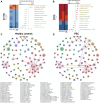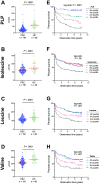Altered Gut Microbial Metabolism of Essential Nutrients in Primary Sclerosing Cholangitis
- PMID: 33387530
- PMCID: PMC7611822
- DOI: 10.1053/j.gastro.2020.12.058
Altered Gut Microbial Metabolism of Essential Nutrients in Primary Sclerosing Cholangitis
Abstract
Background & aims: To influence host and disease phenotype, compositional microbiome changes, which have been demonstrated in patients with primary sclerosing cholangitis (PSC), must be accompanied by functional changes. We therefore aimed to characterize the genetic potential of the gut microbiome in patients with PSC compared with healthy controls (HCs) and patients with inflammatory bowel disease (IBD).
Methods: Fecal DNA from 2 cohorts (1 Norwegian and 1 German), in total comprising 136 patients with PSC (58% with IBD), 158 HCs, and 93 patients with IBD without PSC, were subjected to metagenomic shotgun sequencing, generating 17 billion paired-end sequences, which were processed using HUMAnN2 and MetaPhlAn2, and analyzed using generalized linear models and random effects meta-analyses.
Results: Patients with PSC had fewer microbial genes compared with HCs (P < .0001). Compared with HCs, patients with PSC showed enrichment and increased prevalence of Clostridium species and a depletion of, for example, Eubacterium spp and Ruminococcus obeum. Patients with PSC showed marked differences in the abundance of genes related to vitamin B6 synthesis and branched-chain amino acid synthesis (Qfdr < .05). Targeted metabolomics of plasma from an independent set of patients with PSC and controls found reduced concentrations of vitamin B6 and branched-chain amino acids in PSC (P < .0001), which strongly associated with reduced liver transplantation-free survival (log-rank P < .001). No taxonomic or functional differences were detected between patients with PSC with and without IBD.
Conclusions: The gut microbiome in patients with PSC exhibits large functional differences compared with that in HCs, including microbial metabolism of essential nutrients. Alterations in related circulating metabolites associated with disease course, suggesting that microbial functions may be relevant for the disease process in PSC.
Keywords: Branched Chain Amino Acids; Microbiome; Primary Sclerosing Cholangitis; Vitamin B.
Copyright © 2021 The Authors. Published by Elsevier Inc. All rights reserved.
Figures






Comment in
-
Feeding the Gut-Liver Axis in PSC: What Makes It Different from IBD?Gastroenterology. 2021 Sep;161(3):1070-1071. doi: 10.1053/j.gastro.2021.05.028. Epub 2021 May 18. Gastroenterology. 2021. PMID: 34015335 No abstract available.
References
-
- Karlsen TH, Folseraas T, Thorburn D, et al. Primary sclerosing cholangitis – a comprehensive review. J Hepatol. 2017;67:1298–1323. - PubMed
-
- Kummen M, Holm K, Anmarkrud JA, et al. The gut microbial profile in patients with primary sclerosing cholangitis is distinct from patients with ulcerative colitis without biliary disease and healthy controls. Gut. 2017;66:611–619. - PubMed
-
- Lemoinne S, Kemgang A, Belkacem K Ben, et al. Fungi participate in the dysbiosis of gut microbiota in patients with primary sclerosing cholangitis. Gut. 2020;69:92–102. - PubMed
Publication types
MeSH terms
Grants and funding
LinkOut - more resources
Full Text Sources
Other Literature Sources
Miscellaneous

